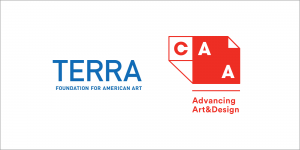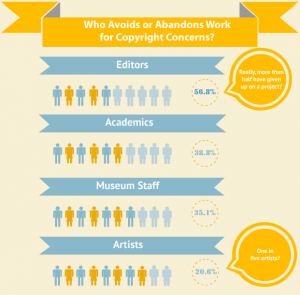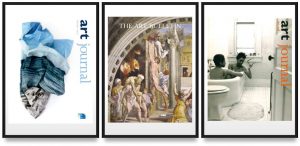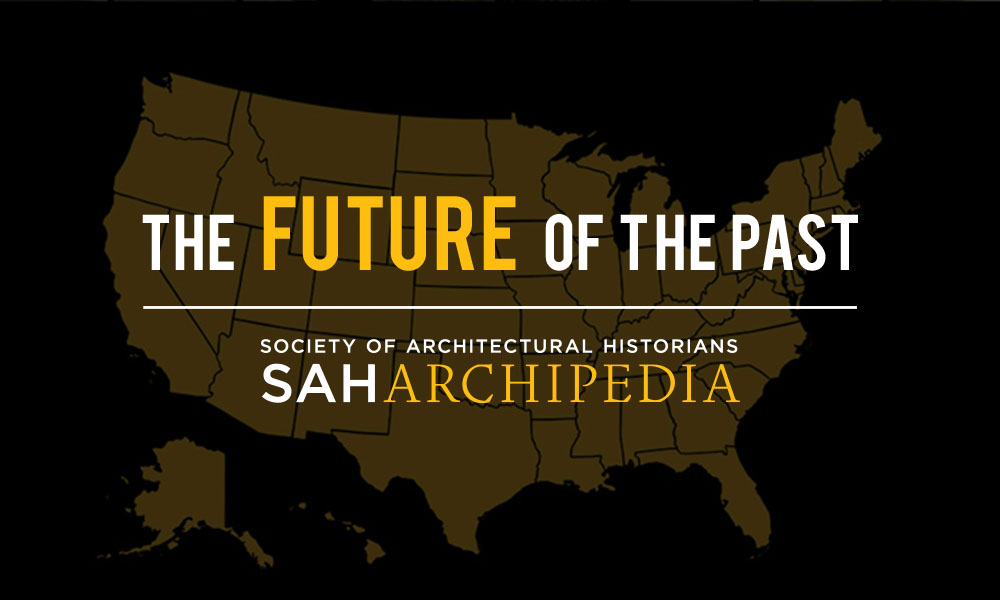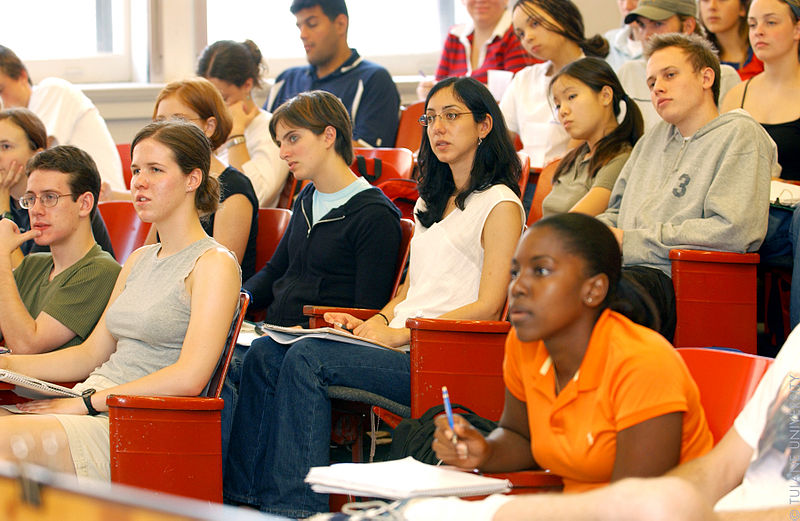CAA News Today
Meet the 2021 Recipients of Terra Foundation for American Art Research Travel Grants
posted by CAA — July 19, 2021
We’re delighted to announce fourteen scholars have been awarded Terra Foundation for American Art Research Travel Grants in 2021.
These grants provide support to doctoral, postdoctoral, and senior scholars from both the US and outside the US for research topics dedicated to the art and visual culture of the United States prior to 1980.
International Research Travel Grants for US-based Scholars
Doctoral Scholars
Thomas Busciglio-Ritter, The University of Delaware, “‘The Union of Excellences’: An Atlantic History of Early American Landscape Views (1790–1860)”
Ann Tartsinis, Stanford University, “Modernism in Pieces: Transatlantic Visual Culture Between the Wars”
Postdoctoral & Senior Scholars
Caroline Riley, Boston University, “Thérèse Bonney’s Photography: The Politics of Art, the Body,and War from 1920–1970”
Nadia Sethi, University of Washington, “Alaska Native Cultural Belongings held in Museums in Estonia, Finland and Sweden”
Kay Wells, University of Wisconsin-Milwaukee, “Uncanny Revivals: Designing Early America during the Rise of Fascism”
International Research Travel Grants to the United States
Doctoral Scholars
Max Böhner, Humboldt-Universität zu Berlin, Germany, “Twilight Aesthetics: Queer Visual Culture in the United States Between 1945 and 1969”
Sarah Happersberger, Justus-Liebig-Universität Giessen, Germany, “Connection, Community, Kinship, Network: Women Artists Performing Togetherness in the Long 1970s”
Jacqueline Mabey, University College London, England, “This Must Be the Place: Mapping Artistic Kinship and Economic Change in Downtown New York, 1973–1987”
Ana Gabriela Rodriguez, The Courtauld Institute of Art, England, “Tracing Puerto Rican Graphic Arts: Bridging Workshops and Crossing Borders, 1940s –1970s”
Frances Varley, The Courtauld Institute of Art, England, “Identity, Provincialism and Modernism in the US and Britain from a Comparative Perspective, c. 1870–1914”
Wen Yao, The University of York, England, “A Travelling Surrealist: Mobility and Representation in Stella Snead’s Paintings, Photographs and Collages Made in the US (1940–1980)”
Postdoctoral & Senior Scholars
Dafne Cruz Porchini, Universidad Nacional Autónoma de México, “Jean Charlot: A French Artist in the United States and Mexico (1921–1944)”
Maria Stavrinaki, Université Paris I Panthéon–Sorbonne, France, “‘After History’: Variations on a Theme in the Art and Thought of the 1950s–1960s”
Emily Warner, Independent Scholar, “Abstraction Unframed: Abstract Murals at Midcentury”
Learn more about the Terra Foundation Research Travel Grants
An Interview with Suzanne Preston Blier on CAA’s Code of Best Practices and Publishing with Fair Use
posted by CAA — May 19, 2020
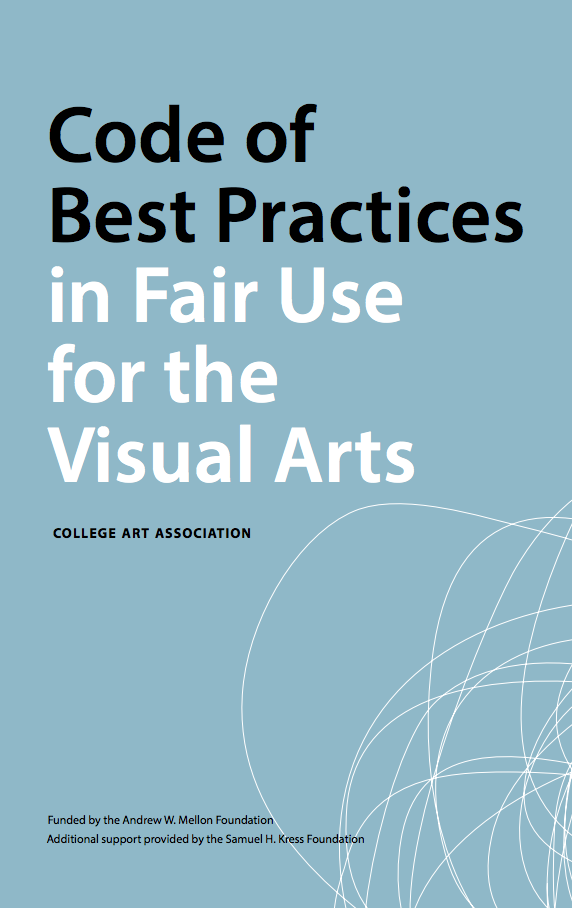 In 2019, Suzanne Preston Blier, professor of African art at Harvard University and former president of CAA, published a major book on Picasso’s use of global imagery, Picasso’s Demoiselles: The Untold Origins of a Modern Masterpiece. In addition to its scholarship the book is groundbreaking for its reliance on fair use, the principle within US copyright law that permits free reproduction of copyrighted images under certain conditions. CAA led the way among visual arts groups in calling for reliance on fair use, producing in 2015 its Code of Best Practices in Fair Use for the Visual Arts.
In 2019, Suzanne Preston Blier, professor of African art at Harvard University and former president of CAA, published a major book on Picasso’s use of global imagery, Picasso’s Demoiselles: The Untold Origins of a Modern Masterpiece. In addition to its scholarship the book is groundbreaking for its reliance on fair use, the principle within US copyright law that permits free reproduction of copyrighted images under certain conditions. CAA led the way among visual arts groups in calling for reliance on fair use, producing in 2015 its Code of Best Practices in Fair Use for the Visual Arts.
In this interview with Patricia Aufderheide, university professor and founding director of the Center for Media & Social Impact (CMSI) at American University, and a principal investigator in the CAA fair use project, Blier relates how she became an inadvertent pioneer of fair use in art history.
An Interview with Suzanne Preston Blier, Harvard University
By Patricia Aufderheide, American University
I met Prof. Blier, an award-winning art historian, when CMSI joined others in facilitating the Code of Best Practices in Fair Use for the Visual Arts for the College Art Association (CAA), with funding from the Samuel H. Kress and Andrew W. Mellon Foundations. Fair use is the well-established US right to use copyrighted material for free, if you are using that material for a different purpose (such as academic analysis, for instance) and in amounts relevant to the new purpose. Blier was the incoming president, as the Code launched.
The project addressed a huge need. Art historians, visual artists, art journal and book editors, and museum staff all have faced major hurdles in accomplishing their work because of copyright. Art historians avoided contemporary art in favor of analyzing public domain material. Visual artists hesitated to undertake innovative projects that reuse existing cultural material. Editors, or sometimes their authors, faced monumental bills for permissions and sometimes those permissions depended on an artist or artist’s estate agreeing with what they say. Museums hesitated to do virtual tours, or use images in their informational brochures, or even to mount group exhibits, because of prohibitive permissions costs. All together, some people in the visual arts called this “permissions culture.”
Once the Code came out, some things changed immediately. Museums rewrote their copyright use policies. Artists made new work. CAA’s publications—some of the leading journals in the field—adopted fair use as a default choice.Yale University Press prepared new author guidelines for fair use of images in scholarly art monographs to encourage fair use. Blier was one of the Code’s champions.
And then she needed it herself. As she began work on her most recent book, which ultimately resulted in Picasso’s Demoiselles: The Untold Origins of a Modern Masterpiece (Duke University Press, 2019, winner of the 2020 Robert Motherwell Book prize for an outstanding publication in the history and criticism of modernism in the arts by the Dedalus Foundation), she realized the subject faced the stiffest possible copyright challenge. To tell her story, she would have to be able to show images from a variety of artists, most challengingly, Picasso. She thought of Duke University Press, a publisher that has been willing to go ahead of others on fair use. So Blier approached them. Duke was very supportive, and they ended up hiring extra legal counsel for this. In the end, Blier said, she had to rewrite certain sections, and redo some images at the suggestion of outside counsel, to strengthen the fair use argument.
Blier tells the story of how the book got out into the world (and won an award), below.
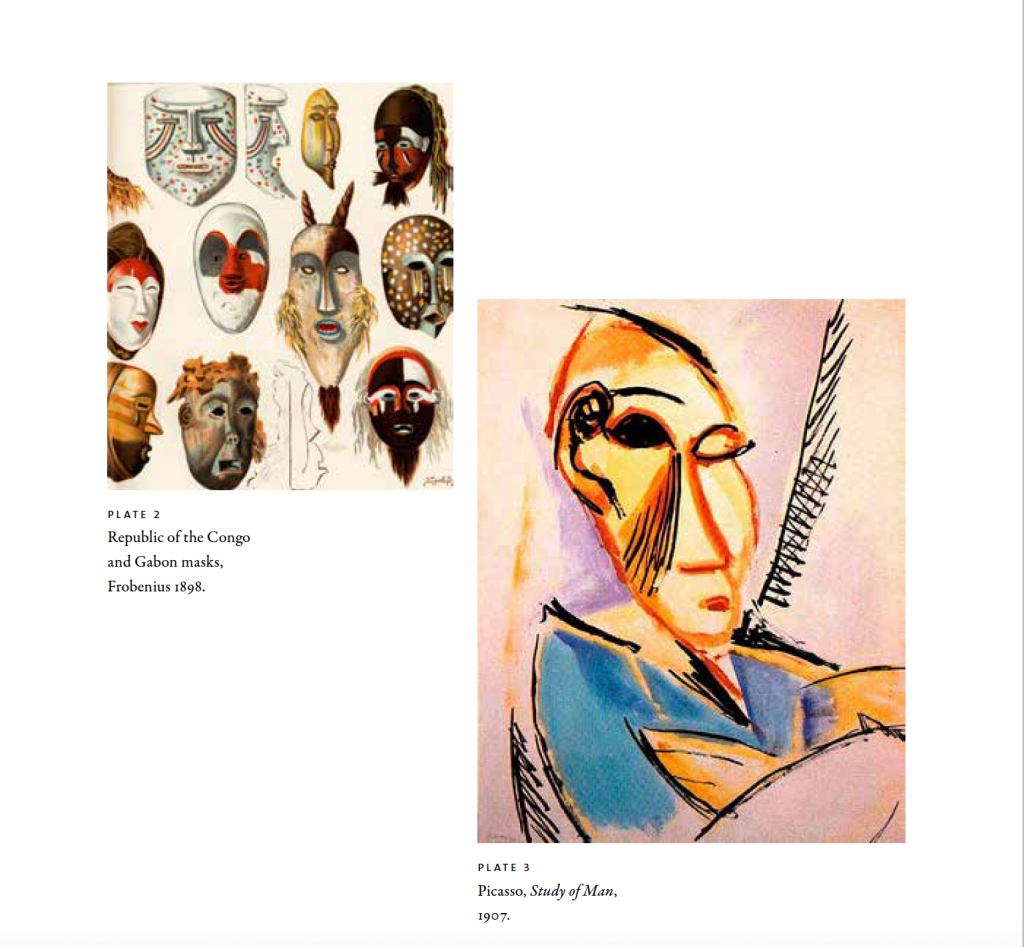
Figure 1. Congo masks published in Leo Frobenius’ 1898 Die Masken und Geheimbünde Afrikas alongside Pablo Picasso’s Study of Man (1907). The Congo mask at the bottom, second from the left is the likely source for the crouching demoiselle. The mask at the top left shows tear lines from the eyes crossing diagonally down the cheeks similar to Picasso’s preliminary study for one of the men in an early compositional drawings for the canvas.
You’re an expert in African art. How did you end up writing a book about one of the most famous modernist artists?
This is a book I never intended to write; it found me. For my previous book, Art and Risk in Ancient Yoruba: Ife History, Power, and Identity, I was doing those last-minute bits of work in the library to check sources, and I pulled out a book adjacent to the book I was looking for, an old book by the German anthropologist, Leo Frobenius. I hadn’t read it since graduate school. As I opened it up, I looked down and I said, Wow, this is a book on African masks and they look like they’d be the ones Picasso used as models for his famous 1907 painting Demoiselles d’Avignon. At the time I had first read the book, Picasso’s drawings for the painting hadn’t been released. This time I saw it differently and as I was looking at it in the library, I saw there was tracing paper over the pictures. There was a line drawing covering each mask, and that seemed significant too.
The next thing I knew, I was hunting for a book from the Harvard library on Dahomey women warriors. It turned out it was in the medical school library, which should have been a sign. When I picked it up at the main library and flipped it open, I thought, Oh my god, it’s pornography! It was photos and line drawings of women around the world, in supposed “evolutionary” order. Photos of naked women begin with so-called “archaic,” in Papua New Guinea, right through to southern Europe, then Denmark. In the library I’m bending over, kind of hiding it, out of embarrassment. I bring it home and realize, Ohhhh! Here’s another key source for Demoiselles. This volume, which was by Karl Heinrich Stratz, had gone through multiple editions, and one was published about the same time Picasso stopped using living models. Then I found another book, by Richard Burton, which had a rendering that Picasso clearly used for his 1905 sketch Salomé.
What happened next was the clincher. I went to Paris to lecture at Collège de France. The week before my lectures, I went to hear another speaker at the Collège, a medieval historian. One of the first slides he presented was a work from a medieval illustrator, Villard De Honnecourt. This book was a modern edition of an illustrated medieval manuscript, published in the right time frame for Picasso to have seen it. And I thought, Well, here’s another source Picasso used.
Later I was also able to rediscover a photo that allowed me to date the painting to a single night in March 1907. The scene is often identified as a brothel, but bordel in French doesn’t mean bordello, but rather a chaotic or complex situation. It was my belief that Picasso was creating a time-machine kind of image of the mothers of five races, as he understood them from the Stratz ethno-pornography book and other sources, each depicted in the art style of that region or period. My larger argument is not only that Picasso was using book illustration sources, but also that these books invite us to see the canvas in a new light, and that, for Picasso, the painting has its intellectual grounding in colonial-era ideas about human and artistic evolution.
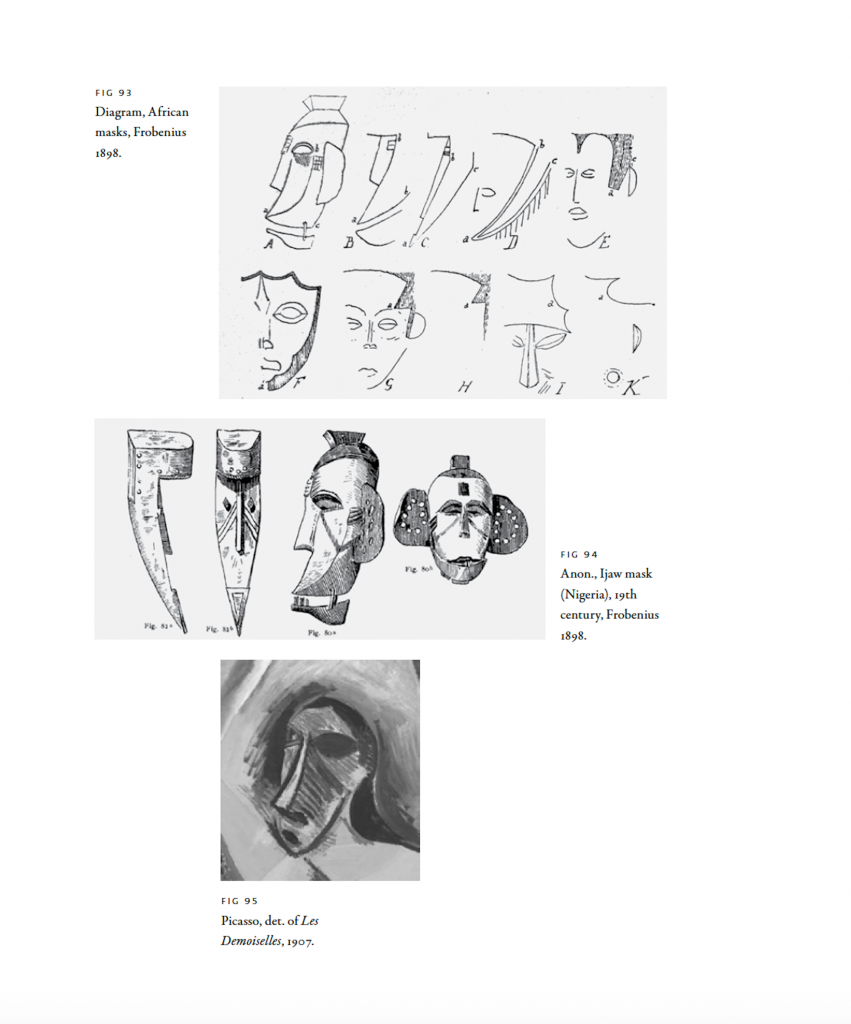
Figure 2. Illustrations from Leo Frobenius’ 1898 Die Masken und Geheimbünde Afrikas showing (top two rows) the visual development of a mask into a human face. The middle illustration ,from the same Frobenius book shows line drawings of ijaw masks from Nigeria. The bottom image is a detail of the standing African figure from Picasso’s 1907, Les Demoiselles d’Avignon which appears to be based on a combination of these two masks.
What a sleuthing job! And so you decided to write the book then?
I wrote the first two chapters while I was in Paris doing the lecture. I saw it not as a coffee-table art book, but the kind of book you put in your knapsack as you head off to a long ride on the subway.
It was easy to write, but it was a very different story for the images. I immediately got a trade publisher in Britain to agree to publish it, and then they said they could not do it, because of problems getting permission to reproduce images from the Picasso Foundation.
The Picasso Foundation is notorious for making it difficult to access Picasso images, isn’t it?
The price of permissions is high, and this Foundation like many estates is interested in guarding the artist’s reputation as well. The difficulties of publishing on Picasso have been manifested in how little publishing was being done, and how scarce the images were in that work. Since 1973, there have been few heavily illustrated books about Picasso, except by wealthy individuals or museums in relation to an exhibition. I had heard about Rosalind Krauss publishing a work without permissions—at least that’s what I heard—anyway, she used very few images. Leo Steinberg apparently had not been able to arrange the rights for a work he wanted to do, a book edition of his two seminal articles on Les Demoiselles.
Although I hadn’t realized it until recently, in September 2019 there was an important case in the US, about a set of illustrated books by Christian Zervos with a wide array of Picasso illustrations. The case was started in France, but a US judge has allowed fair use.
But generally, yes, there’s common wisdom among art historians that the Picasso Foundation is a formidable challenge.
So how did you proceed when the first publisher backed out?
I was disheartened, but I got an agent. He sent it off to ten or twelve trade publishers worldwide—and came up with nothing.
Then I realized I was going to have to go to a university press. That was a big decision. The trade publication will pay for the images, and do all the work on the rights clearance. But with a university press, you’re on your own.
One of the first people I contacted was legendary editor Ken Wissoker at Duke University Press. He was interested, but then came the issue of the images. I may have broached fair use with him from the start. The manuscript had gone through peer review and it was in great shape except for this copyright issue. I had quite a number of images—in the end, it was 338. At Duke, they won’t begin the editorial process until you have all the copyright clearances on images done. So I began the difficult process of deciding how to get the images.
Were you in contact with the Picasso Foundation directly?
I did contact them, in order to let them know about the project in general. I was doing final research work in Paris. I had framed the book as a travelogue in part addressing my discovery of these sources. I also wanted to find out so much more about Picasso. I’m not a modernist, I’m an outsider to the field. So I worked hard to get as much insight and criticism of the manuscript from specialists as I could.
I made it a point to meet with people at the Picasso Foundation. I had a Powerpoint of the images, which I showed to one of the key people there. Later I wrote to them, “here’s the manuscript, let me know if you have any thoughts.” And I heard nothing back. I had heard that with some manuscripts, they have been concerned one way or another. I didn’t want their permission for the intellectual content, but since they knew this artist and his life and family better than any academic could, I wanted their insights.
And then you started to look for permissions?
Well, I began to think about the cost of acquiring the images. The process is such that you have to go through the Artists Rights Society (ARS, a US licensing broker). And to get a price, you have to furnish the number of images, how many are color, the size of the print run, the prospective profit, and a whole series of things we could not know. Duke wouldn’t even look at the project editorially without having the rights in hand. I had heard difficult stories—that they were interested in looking at the galleys along the way, and requesting changes, for quality control, but it wasn’t possible to do this and work with the press.
If I had to guess, I would say that it might have cost me something like $80,000 of my own money to purchase the minimum number of images for this scholarly book, from which I expect to make no money, or very little.
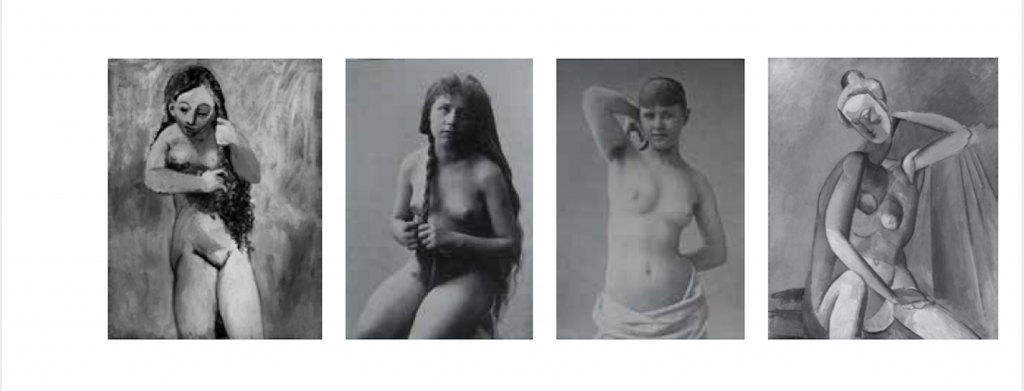
Figure 3 from left to right: Pablo Picasso, Nude Combing Her Hair, 1906; Girl braiding hair from C. H. Stratz, La beauté de la femme, 1900 (Paris); Girl from Vienna from C.H. Stratz, La beauté de la femme, 1900; Picasso Seated Female Nude, 1908. Over the course of his long career Picasso would continue to use key visual insights from Frobenius, Stratz, and other illustrated sources he was exploring in this late 1906 to early 1907 period.
So how did you come to the decision to use them under fair use?
I had been president of CAA in 2016-17, and a longtime promoter of fair use and IP issues more generally. I was involved in the creation of the Code of Best Practices in Fair Use for the Visual Arts. For me, CAA’s role in fair use is one of the most important and radical (in a positive way) things that it has ever done.
I decided that fair use would make the most sense in this context. This was a book about an important modern artist. In addition, I’m a senior scholar—this was not my first publication. If the worst happened, if I had problems, well, I’ve had a great career and this would not harm it. I have tenure and so on. Also, as the then-president of CAA, I thought it was important to do this.
Besides, this to me was part of a larger picture of what I had done in my larger career. I’m very active locally in civic affairs, and really interested in promoting transparency, and democratic ideals. I was also very fortunate to have Peter Jaszi, a foremost legal scholar on fair use (and another principal investigator on the CAA project), working with me. At his suggestion, I took out an insurance policy, which for a fee—I think about $5,000—(with a $10,000 deductible) I was able to lower my anxiety level. I also paid $400 for an attorney to look over the insurance contract. And I had good friends like you, who when I got cold feet assured me it was the right thing to do. And of course, Duke is a publisher that has been willing to go ahead of others on fair use.
Can you give me an example of something you had to change in the text to strengthen the fair use argument?
With a museum photograph of an African mask, for example, I had to explain why this particular way of photographing the work was critical to the argument in my book. I had to ad a few sentences to justify my selection of several Picasso works as well. I also had to give reasons in my text for why each of the chapter epigraphs was necessary.
Did you have to alter the use of imagery in any way to accommodate fair use?
There are changes the press made, design-wise, that reflected in part the decision to employ fair use. Many of the photos are shown in black-and-white and the majority are reduced in size. I was constrained by the fact that I could only employ fair use if I could get access to the materials without going through the Picasso Foundation. So I had to acquire nearly all the images from published books, and many of the Picasso images were published in black and white and at a very small size, in a grainy context. I had to spend a lot of time hunting down the best possible images to use. In my book they are shown in relatively small size, along with information on where you can find color versions online.
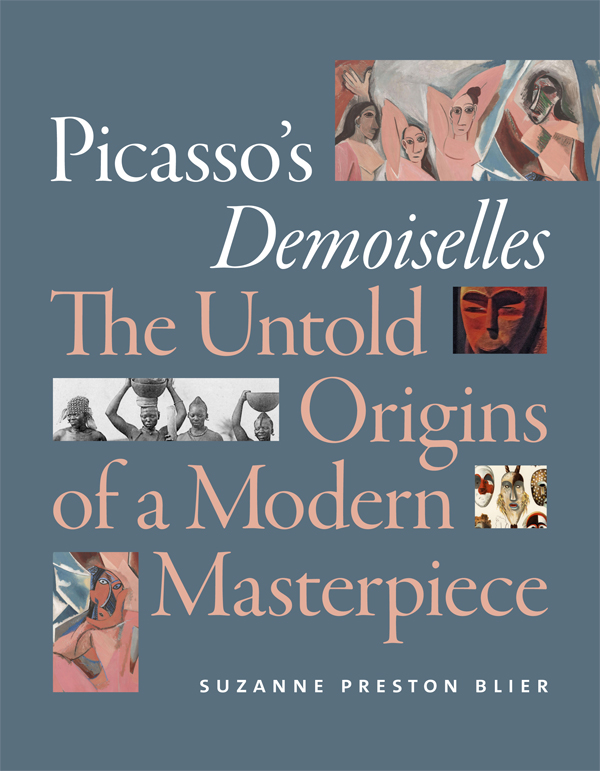
That didn’t bother me too much, though. For readers and viewers at this juncture in the Internet era, we have become expert at extrapolating the fuller figure from a small image.
There is also a small spread of color images, a couple Picasso works as well as from other artists. For these images color was central to the book.
The decision to publish largely in black-and-white was, I think, also related to the fact that the Picasso Foundation and others are concerned that color representations be incredibly accurate, and it is very hard to get the color exactly right, when copying from books. You also have an issue with paper quality in getting accurate representation.
The cover is a handsome design, and very clever. They broke up the images into thumbnail-like sections, requiring you as a viewer to put them together as one image, similar to how Picasso was thinking in the early stages of cubism, where you as a viewer of an assemblage have to assemble them in your own mind, to make it work for you as a whole.
How was the book received?
It was a finalist for the Prose Prize, a prize of publishers to authors. My previous book won it in 2016. I didn’t expect to win it this time again, in 2019. I was very honored that it was a finalist. It was also featured in the Wall Street Journal’s holiday art book list. And then, just recently, it won the Robert Motherwell Book Award.
Has the Picasso Foundation seen the book?
To date I’ve heard nothing. I was thinking earlier that the Picasso Foundation might want to stop it pre-publication. So much so that when I came back from travel in Africa, I went first to my academic mailbox, and was relieved when I saw no big legal envelope. But there has been no pushback. I certainly gave them the opportunity to comment on the content while it was still in manuscript. And last April or May, I went to France to meet with the curators at Musée Picasso about contributing an essay to a catalog. I sent them an article draft which they decided not to publish, which is fine, but also sent them a copy of the manuscript, and of course the Musée speaks to the Foundation.
Interestingly, the two cases where the Foundation has sued or prevented publication that I know of have to do with children’s books about Picasso. I don’t know what that means.
Does the wider art history community know about this?
I hope this personal story makes a difference. We still have a lot of educating to do, in spite of the work we did around the Code. I continually get, on the art history listservs, questions—How can I get permission, and I always say, Use fair use. People still don’t trust it or believe it’s more difficult than it is.
At the CAA conference I just went to in Chicago, there seems to be a division between presses. Presses at private universities–Yale, Princeton, MIT, Duke—seem to feel more comfortable exploring this. But for university presses at some public institutions, these legal issues have to be taken up with the state attorney general, and there can be real nervousness stepping outside a narrow parameter. I learned this speaking to an editor at a state university press in a progressive state, who believes they’re being held back because of this fear.
I was pleased to see at this same conference a pamphlet on fair use by Duke University Press’s former Director, Steve Cohn. In his essay, he mentions my Picasso book and how happy he is that Duke chose to publish it this way. I figured, if Steve is openly talking about this fair use project, then the proverbial cat is out of the bag, and I could be more open and provide some of the back story from my end.
CAA’s scholarly publications, The Art Bulletin, Art Journal, and Art Journal Open rely on fair use as a matter of policy, and indicate when they do so in their photo credits. View a complete discussion of fair use and CAA’s Code of Best Practices.
Announcing Research Travel Grants Funded by the Terra Foundation for American Art
posted by CAA — September 26, 2019
We’re pleased to announce our administration of the Terra Foundation for American Art Research Travel Grants.
Now administered and juried by CAA, the Terra Foundation initiated this grant program in 2003 to fund European candidates. It was expanded to reach candidates worldwide in 2012, and opened to US-based researchers in 2017 to travel abroad, developing American art scholar networks around the world with a total of 173 grantees since its inception.
The Research Travel Grants will be awarded annually, providing support to doctoral, postdoctoral, and senior scholars from both the US and outside the US for research topics dedicated to the art and visual culture of the United States prior to 1980.
“We are excited to expand our partnership with the Terra Foundation to provide continued support for scholars of American art,” said David Raizman, interim executive director of CAA. “Research funding for domestic and international scholars is essential to the vitality of the field, and these generous grants from the Terra Foundation will facilitate the advancement of their work. The inclusion of international scholars for these grants is especially gratifying, as it promotes new perspectives and engages the wider scholarly community.”
The grants foster firsthand engagement with American artworks and art-historical resources; build networks for non-US-based scholars studying American art; and expand access to artworks, scholarly materials, and communities for US-based scholars studying American art in an international context.
Awards of up to $9,000 will be granted on a per project basis by a jury formed by CAA. The first awards will be announced in March of 2020.
CAA’s administration of the Terra Foundation for American Art Research Travel Grants continues a long history at CAA of supporting travel and scholarship for professionals and students in the visual arts and design. Other grants offered by CAA include the Professional Development Fellowships for Graduate Students, the Terra Foundation for American Art International Publication Grant, the Wyeth Foundation for American Art Publication Grant, the Millard Meiss Publication Fund, the CAA Getty International Program, Travel Grants to the CAA Annual Conference, and introduced last year, the Art History Fund for Travel to Special Exhibitions.
ABOUT THE TERRA FOUNDATION FOR AMERICAN ART
The Terra Foundation for American Art is dedicated to fostering exploration, understanding, and enjoyment of the visual arts of the United States for national and international audiences. Recognizing the importance of experiencing original works of art, the foundation provides opportunities for interaction and study, beginning with the presentation and growth of its own art collection in Chicago. To further cross-cultural dialogue on American art, the foundation supports and collaborates on innovative exhibitions, research, and educational programs. Implicit in such activities is the belief that art has the potential to both distinguish cultures and unite them.
Announcing New CAA Professional Committees
posted by CAA — August 08, 2019
CAA is pleased to announce the creation of two new professional committees: a Committee on Research and Scholarship, and a Services to Historians of Visual Arts Committee. The new committees were approved by the Board of Directors at their May 2019 meeting. Concurrent with our annual call for new committee members, we seek applicants to form the inaugural teams for these two new committees.
The deadline for these applications is October 1, 2019, for new committee service to begin at the Annual Conference in February 2020.
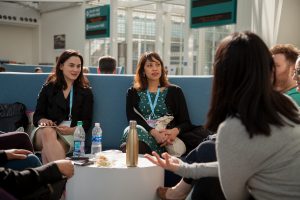
Discussion group at 2018 CAA Annual Conference. Photo: Rafael Cardenas
The formation of these new committees responds to requests from our membership and to a desire to be forward-looking in addressing the professional needs of our fields.
The Committee on Research and Scholarship will offer a resource to all members engaged in the production or consumption of scholarly research.
The Services to Historians of Visual Arts Committee will identify and address concerns facing the historian members of our organization (encompassing specialists in any facets of art, architecture, design, material culture, and visual culture).
The Services to Historians of Visual Arts Committee is intended to recognize our organization’s enduring support for historians, offering them a presence and a voice similar to the role played by other profession-specific committees in our organization (such as the Services to Artists Committee and the Committee on Design). As noted in the committee charge, the Services to Historians of Visual Arts Committee “offers a forum for the discussion of issues of mutual interest across the discipline’s many diverse fields and methodologies. In a climate of great threat to the survival of history of art and history of visual arts programs, this committee provides a locus for advocacy issues particular to historians in these areas of interest.” It is understood that the committee will play an active role in the Annual Conference but is also intended to serve as a central hub and resource for communication among historians of the visual arts well beyond the chronology of conference programming.
As stated in the committee charge, the Committee on Research and Scholarship is charged with “gathering information, [and] assessing and proposing organizational advocacy for CAA on matters concerning the research and scholarship in visual arts and design, encompassing all facets of research regarding history, theory, education and practice.” Specialists in the visual arts—whether practitioners or historians—face unique challenges in the production of their scholarship, such as the cost of image permissions, the closures or reorganization of academic presses, and/or the misalignment of the multiyear workflow of exhibitions or excavations against the strictures of a tenure clock. A scholar’s type of institutional affiliation, or independent scholar status, has an enduring impact on the types of research and scholarship that can be produced—arguably in more profound ways than in other humanities or arts fields. The Committee on Research and Scholarship will provide a vital hub to our members interested in addressing any of these areas of concern—or advancing other concerns or questions concerning the area of research and scholarship.
If you wish to apply for either of these new committees, send an email to Vanessa Jalet at vjalet@collegeart.org with a brief statement of interest and attach a reduced résumé (no more than 2-3 pages).
Kindly also enter in the subject line: “Applicant for Committee on Research and Scholarship” or “Applicant for Services to Historians of Visual Arts Committee”
Deadline: October 1, 2019
Committee on Research and Scholarship Charge
The Committee on Research and Scholarship is charged with gathering information, assessing trends, and proposing organizational advocacy for CAA on matters concerning the advancement of research and scholarship in visual arts and design, encompassing all facets of research regarding history, education, and practice. Recognizing that professionals must navigate a rapidly-transforming field of options for conducting research and disseminating the results thereof, the committee is responsible for assisting the organization in engaging with current issues and serving its membership in this important facet of their professional life.
Services to Historians of Visual Arts Committee Charge
The Services to Historians of Visual Arts Committee identifies and addresses concerns facing historians of art, architecture, design, material culture, and visual culture. It creates and implements programs and events at the conference and beyond. It offers a forum for the discussion of issues of mutual interest across the discipline’s many diverse fields and methodologies. In a climate of great threat to the survival of history of art and history of visual arts programs, this committee provides a locus for advocacy issues particular to historians in these areas of interest. The Committee lends support and mentorship for both seasoned and emerging professionals. It is also charged with maintaining dialogue with other professional organizations and affiliated societies focused on the history of art, architecture, design, material culture and visual culture.
An Interview with Amy Meyers, Recently Retired Director of the Yale Center for British Art
posted by CAA — July 26, 2019
In June, Amy Meyers ended a long and fruitful career as Director of the Yale Center for British Art, which she led for seventeen years. Prior to her appointment in 2002, she spent much of her career at research institutes including Dumbarton Oaks; the Center for Advanced Study in Visual Arts at the National Gallery of Art, Washington, DC; and The Huntington Library, Art Collections, and Botanical Gardens. She also taught at the California Institute of Technology, the University of Michigan, Mount Vernon College, and Yale, and has written extensively on the visual and material culture of natural history in the transatlantic world.
Joelle Te Paske, CAA Media and Content Manager, corresponded with Amy over email to reflect upon her tenure at the YCBA, her experiences with CAA, and her plans for the future. Read the interview below.
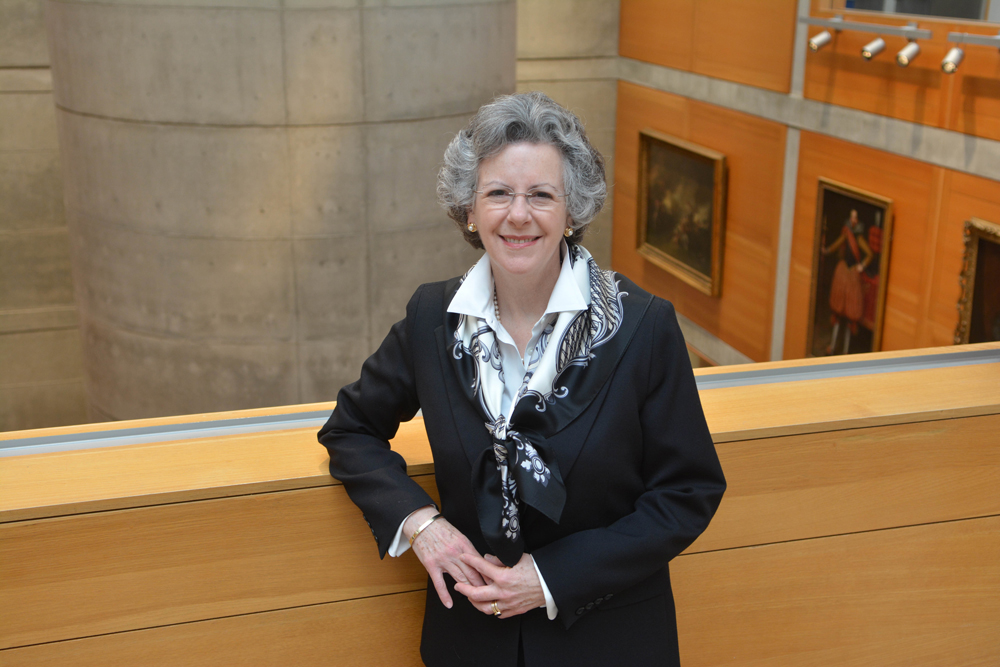
Amy Meyers, Yale Center for British Art, photo by Michael Marsland
Joelle Te Paske: Amy, thank you so much for speaking with us. To begin, what pathways led you to the Yale Center for British Art (YCBA)?
Amy Meyers: There is no question that my experiences as a graduate student at Yale set the stage for my return to direct the Yale Center for British Art 25 years following my arrival as a doctoral candidate in American Studies, in the fall of 1977—the first year the magnificent collections of the newly opened YCBA were accessible to students.
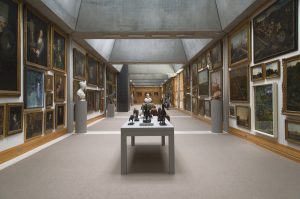
Long Gallery after reinstallation, Yale Center for British Art, photo by Richard Caspole
I had come to Yale to write a dissertation on the photographers who accompanied the federal geological surveys of the American West following the Civil War, and my interest in the art of empire brought me to explore the staggering collections of paintings, prints, drawings, maps, rare books, and manuscripts amassed by the Center’s founder, Paul Mellon, relating to the depiction of the natural world, particularly in the Americas.
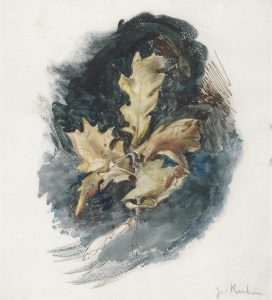
John Ruskin, Study of an Oak Leaf, undated, pen and brown ink with watercolor over graphite heightened with gouache and gum; verso: graphite on paper, Yale Center for British Art, Paul Mellon Collection
The following spring, I enrolled in one of the first courses held at the Center—a seminar on Ruskin, taught by George Hersey. That course included students not only from the Department of the History of Art, but others, who, like me, were interested in the influence of Ruskin’s thought on many aspects of culture, particularly science. Professor Hersey’s important consideration of Ruskin as a major thinker of the nineteenth century, and the discussions that took place in that class between and amongst students, were foundational to my graduate education. I formed collegial friendships with many students who would go on to contribute significantly to art historical scholarship, both in academe and in museums, including David Curry, Bruce Robertson, George Shackelford, Mark Simpson, and Scott Wilcox—and these friendships have informed my scholarship and influenced the way in which I have approached the programs I have had the privilege to run, from the Virginia Steele Scott Gallery of American Art at the Huntington Library, Art Collections, and Botanical Gardens, to the YCBA.
The interdisciplinarity of Professor Hersey’s class reflected Yale’s commitment to exploration across disciplinary boundaries in many areas of study—a commitment that was unusual at American universities in the 1970s. Jules Prown, who had been the YCBA’s first director, creating the institution in concert with Paul Mellon and a distinguished committee of Yale faculty members, was himself devoted to examining the history of art from a broad range of vantage points, and he and his colleagues built that approach into the Center’s culture, both as a research institute and as a public museum with teaching at its heart.

Unidentified man, Paul Mellon, Kenneth Froeberg, and Jules Prown, during the construction of the Yale Center for British Art, 1974, photo by William B. Carter, Yale Department of Public Information, Institutional Archives, Yale Center for British Art
I was privileged not only to study with Jules, but to have him as one of my dissertation advisors. I learned from him the value of the close examination of objects as primary to art historical research, as well as the importance of working collaboratively with groups of scholars in developing the richest, most productive, and enjoyable of research communities. Jules drew around him, through his exciting classes and seminars, a large and devoted coterie of students from across the university who were interested in cross-cultural studies, including art history and material culture—a field he was instrumental in driving forward. Many of the students who took George Hersey’s seminar were part of this group; but others, including Margaretta Lovell (who by then was teaching a course on material culture with Jules), David Lubin, Angela Miller, Rodger Birt, Esther Thyssen, Buffy Easton, Valerie Steele, Catherine Lynn, Rebecca Zurier, Kenneth Haltman, Alexander Nemerov, Richard Powell, and Helen Cooper (who already was serving as Curator of American Paintings at the Yale University Art Gallery) also were active members of Jules’s circle of students (and there were many others who were off writing dissertations, such as Kathleen Foster, or who had graduated relatively recently and were known to us by their groundbreaking work, such as David Solkin). At that time, Bryan Wolf was a young professor of English literature and American Studies who had developed a strong interest in American art, and he also was an important member of Jules’s circle. I was tremendously privileged to have Bryan as one of my dissertation advisors, as well.
The sadly short-lived Center for the Study of American Art and Material Culture, directed by Richard Beard, was established by Robert McNeil, through the Barra Foundation, at the Yale University Art Gallery in the same year that the YCBA opened.
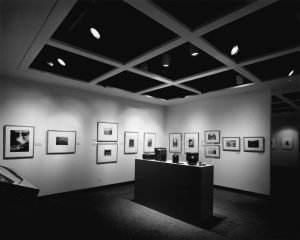
A Survey of American Photographs 1840–1940, installation as presented from March 28–June 6, 1978, organized by the Yale Center for American Art and Material Culture, photo courtesy of the Yale University Art Gallery Institutional Archives
This center both reinforced the community of Americanists at Yale and gave me the opportunity to curate the first of my own exhibitions, American Photographs: 1840 to 1940. The group of Western American historians fostered by my third dissertation advisor, Howard Lamar, and Archibald Hanna, the then-curator of Western Americana at the Beinecke Rare Book and Manuscript Library, also promoted a culture of intellectual exchange, focused quite centrally on the visual culture of the West. Additionally, the American Studies Program offered students and faculty members with cross-disciplinary interests a supportive environment that encouraged innovative, experimental approaches to the study of American culture across the board. Collectively, these centers and programs taught graduate students of my generation at Yale the value of being a member of an engaging and supportive community of intellectual interchange, supported institutionally, and I have no doubt that this experience influenced my interest in being involved in study centers over the course of my professional career.
Indeed, as a graduate student, I was introduced to the vibrant culture of international research institutes when I was awarded a junior fellowship at Harvard University’s Washington-based research institute, Dumbarton Oaks (DO), my dissertation topic having shifted to a broader consideration of the relation of the visual arts to the natural sciences, from the colonial period, through the establishment of the republic, and into the nineteenth century. Some of my closest collegial friendships were formed in the community of DO, including my life-long professional partnership with Therese O’Malley, with whom I presently am organizing an exhibition on John and William Bartram and the emergence of environmental thought in America.
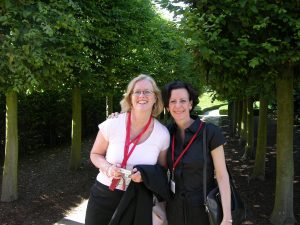
Therese O’Malley and Amy Meyers at a conference at the Royal Botanic Gardens at Kew, 2005.
Therese and I were privileged to be hired by the first dean of the Center for Advanced Study in the Visual Arts (CASVA), at the National Gallery, Henry Millon, to work as predoctoral research assistants for the Architectural Drawings Advisory Group, an international consortium convened at CASVA and supported by the J. Paul Getty Trust to set standards for the scholarly cataloguing of architectural drawings online. This early experience in working with an international group of scholars on one of the first electronic database projects in the history of art stimulated my life-long dedication to advancing the development of electronic tools for art historical research—one that I brought to the Yale Center for British Art when I became director.
The collective of fellowship programs in art history across the museums and research institutes of Washington, DC offered me a rich community of peers as an advanced graduate student and young professional, and this stimulating environment furthered my interest in working within the context of a study center, which had begun at Yale. The appeal of funding art historical research (and research in the humanities more generally) through grants and fellowships was strengthened by the work of my husband, Jack Meyers, an assistant director in the Research Division at NEH at that time—and we have been most fortunate to have developed comparable careers in this regard. While I worked for fourteen years as the Curator of the Virginia Steele Scott Gallery of American Art at the Huntington, which is one of the largest residential fellowship-granting research institutes in the humanities in the world, Jack served as a program officer and then deputy director of the Getty’s Grant Program (now Foundation). We both became fully committed to the support of scholarship internationally, and, over the last years, while I have served as director of the Yale Center for British Art, and CEO of the Paul Mellon Centre for Studies in British Art (PMC) in London, Jack has served as President of the Rockefeller Archive Center. Our complementary positions have allowed us to share our experiences in the running of study centers, which has been wholly gratifying, and, I hope, of benefit to our mutual institutions.
JTP: What would you say are some of the biggest changes you’ve seen during your time at the YCBA?
AM: Certainly the greatest change I have seen in the field of British art over the last seventeen years, which has affected the YCBA and PMC in fundamental ways, and to a certain extent has been promoted by these sister institutions, has been a major shift in vantage point from what commonly has been called the “imperial gaze” to a more global viewpoint. Although by the time I was named director of the YCBA seventeen years ago, the approach to British art had become as much concerned with social history as with connoisseurship, works still were interpreted largely in terms of a relatively closed history of European art. The complex and tragic histories of the British Empire and slave trade were only beginning to affect the ways in which British art was understood, and the canon remained essentially defined as the creation of white, male artists of British birth—or, more generously, of white, male European or colonial American artists who came to practice in the British Isles, or who were associated with British artists and patrons on the Grand Tour.
Over the last years, a sea change has taken place, and not only has the canon expanded—and shifted—to include works by artists from many other parts of the world that came under British dominion or were deeply affected by the Empire, but also by artists of more diverse racial backgrounds and genders. The sense of the West’s ownership of the world on the part of historians of British art has been altered dramatically, and standard practice now insists that even the most traditionally canonical works must be reinterpreted from a global vantage point, and in terms of much larger and more challenging histories.
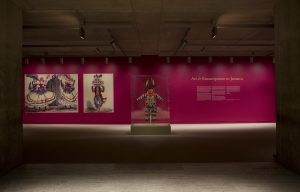
Art and Emancipation in Jamaica: Isaac Mendes Belisario and his Worlds, curated by Tim Barringer, Gillian Forrester, and Barbaro Martinez Ruiz, Yale Center for British Art, 2007, photo by Richard Caspole
JTP: What is a favorite memory—perhaps one that is less well-known—from your time there?
AM: My fond memories from my years at the YCBA—and the PMC—are innumerable, and it is extremely difficult to select a favorite. However, one program stands out as particularly memorable for me personally. In July of 2005, the YCBA co-organized a conference entitled, “Ways of Making and Knowing: The Material Culture of Empirical Knowledge,” with the PMC and the Wellcome Trust Center/Centre for the History of Medicine at University College London (UCL).
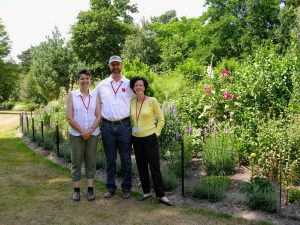
Pamela Smith, Harold Cook, and Amy Meyers, standing in front of a raised flower bed reconstructed from an eighteenth-century plan by garden historian Mark Laird, at Painshill Park, in Cobham, Surrey, during the final session of “Ways of Making and Knowing: The Material Culture of Empirical Knowledge,” July, 2005.
My co-conveners were close associates in the history of science: Pamela Smith, who is the Seth Low Professor of History at Columbia University, and Harold Cook, who, at that time, was director of the Wellcome Trust Center and now is the John F. Nickoll Professor History at Brown University. Beginning with a series of discussions at the Huntington, we planned an interdisciplinary conversation about the material construction of knowledge, examining how artisans and other makers of things informed the ways in which the natural world came to be understood in the West, from the sixteenth-century through the nineteenth. Exploring the relationship between two spheres traditionally understood to be distinct—practical and theoretical knowledge, the lectures and demonstrations were given by the seventy presenters, including art historians and historians of material culture, historians of science, artists, and craftspeople.
The program took place over five days, at sites across London ranging from the Chelsea Physic Garden, the Enlightenment Gallery at the British Museum, the Royal Botanical Gardens at Kew, the Natural History Museum, the Linnean Society, the V&A, and Painshill Park, in Surrey. This experimental program included as many object-study sessions and hands-on making workshops as formal papers, interrogating how the use of natural materials in the processes of making yielded the most profound understanding of nature, feeding science as much as technical knowledge in exciting new ways. A selection of the papers appeared under the title of the conference, in the Bard Graduate Center’s series Cultural Histories of the Material World, published by the University of Michigan Press in 2014. I must say that the support of Brian Allen, at that time the splendid and long-serving Director of Studies of the PMC with whom I had the honor of working closely for ten years, was a special pleasure.
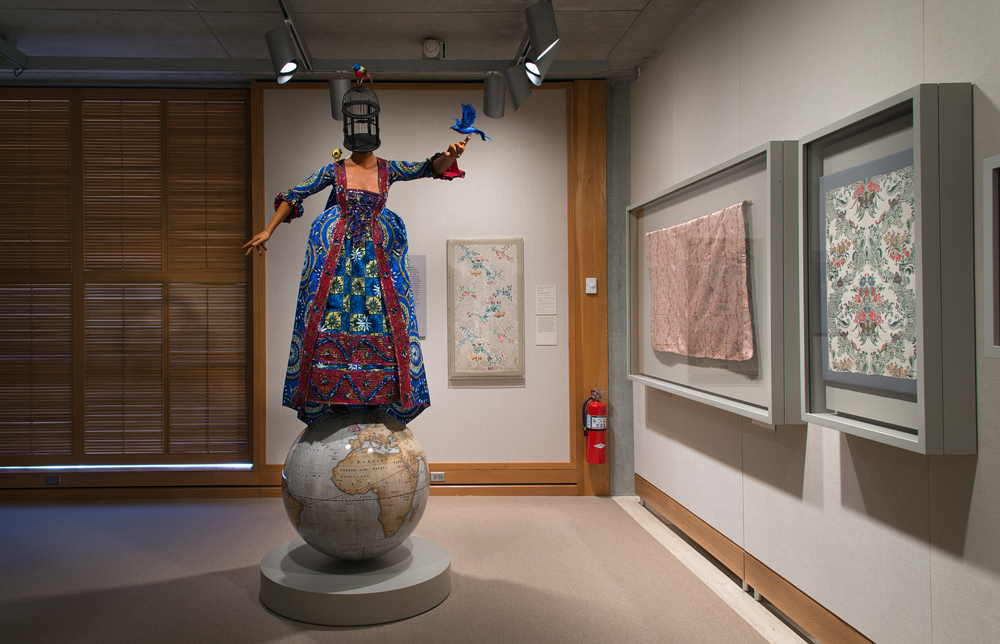
Enlightened Princesses: Caroline, Augusta, Charlotte, and the Shaping of the Modern World installation, including Yinka Shonibare CBE’s Mrs Pinckney and the Emancipated Birds of South Carolina (2017), Yale Center for British Art, photo by Richard Caspole
I also remember with great fondness working with Joanna Marschner, Senior Curator at Kensington Palace, on Enlightened Princesses: Caroline, Augusta, Charlotte, and the Shaping of the Modern World, an exhibition co-organized by the YCBA and Historic Royal Palaces, with the support of the PMC, that was mounted in New Haven and London in 2017. Our mutual interest in women and patronage, particularly in relation to the natural sciences, found its expression in this project, and we look forward to working together on the subject long into the future.
JTP: What is a resource at the YCBA that you think people don’t often know about, but should?
AM: The collection of British art at the YCBA is renowned as the largest and finest outside the UK, comprising over 2,000 paintings; 20,000 drawings and watercolors; 45,000 prints and photographs; and several hundred pieces of sculpture. Much less well known is the institution’s truly glorious rare book and manuscript collection. The Center’s founder, Paul Mellon, began his life as a collector in this field, and over his lifetime he amassed one of the greatest collections formed in the twentieth century, comprising approximately 35,000 titles. Mr. Mellon focused in part on British illustrated books, acquiring the renowned J.R. Abbey collection of British color plate books, which serves as the touchstone for all other collections of this kind. Other major parts of the collection include drawing manuals, sporting books and manuscripts, early maps and atlases, early printed books by Caxton and his contemporaries, and archival and manuscript material relating to British artists, writers, and travelers of all periods.
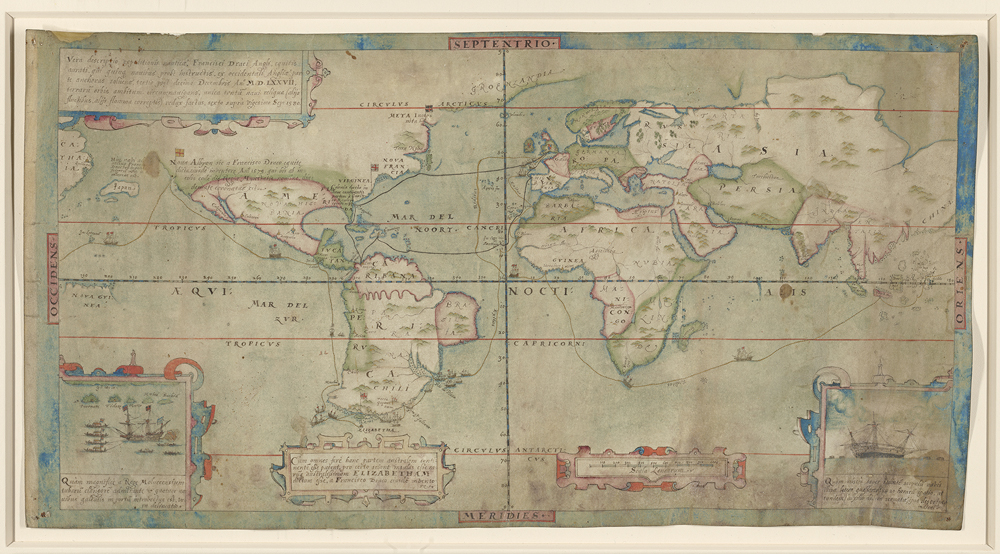
A True Description of the Naval Exploration of Francis Drake, Englishman & Knight, Who With Five Ships Departed from the Western Part of England on 13 December 1577, Circumnavigated the Globe and Returned on 26 September 1580 with One Ship Remaining, the Others Having been Destroyed by Waves or fire, [London (?), ca. 1587], pen and ink and watercolor on parchment, Yale Center for British Art, Paul Mellon Collection
The Rare Books and Manuscripts collection contains splendid photographic holdings, beginning with some of the earliest printed books including original photographic illustrations produced by the first British experimenters with paper-print photography, such as William Henry Fox Talbot. These collections have grown enormously over the years, as have the photographic collections in the Prints and Drawings Department, making the Center one of the most significant repositories of British photographs in the country.
The same holds true for the development of the institution’s collection of contemporary British art, and over the course of this summer, the Center has mounted an exhibition illuminating the role that donors have played in enhancing both areas of the institution’s collections over the last few years. Entitled Photographs/Contemporary Art: Recent Gifts and Acquisitions, the exhibition demonstrates the breadth and depth of these holdings and signals their continued growth.
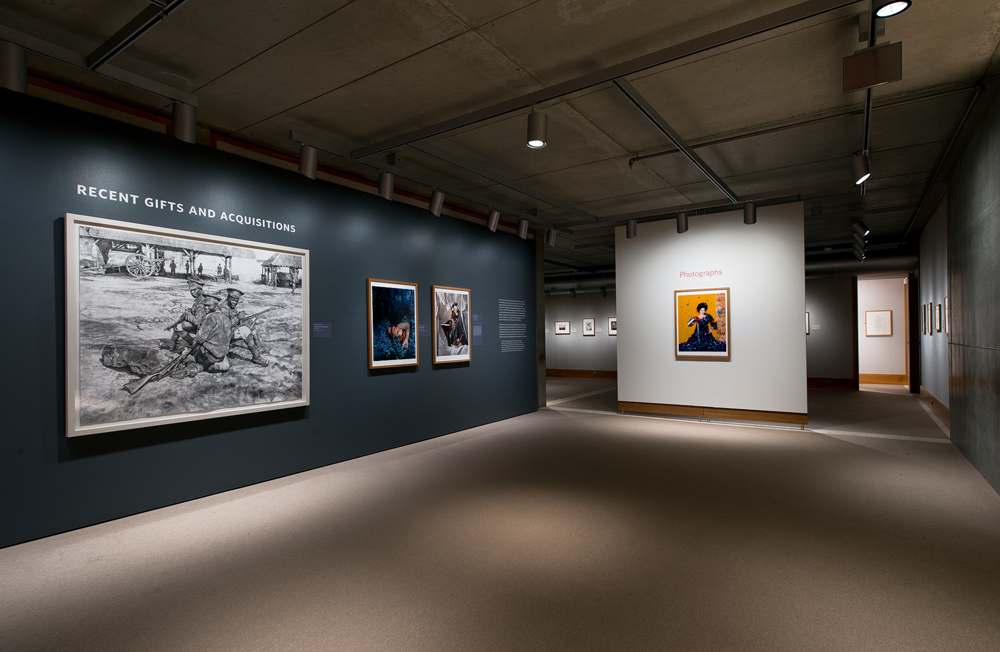
Photographs | Contemporary Art: Recent Gifts and Acquisitions installation, Yale Center for British Art, photo by Richard Caspole
JTP: When did you first become a CAA member? Do you have a favorite memory from a CAA conference?
AM: I have been a member of the CAA for so long that I do not remember precisely when I joined—undoubtedly by the early 1980s, when I was attending conferences regularly in my later years of graduate school. My memories of the very first conference I attended are shrouded in the mists of time, but I believe that I joined a group of Yale graduate students at a conference in New York while I was still enrolled in courses, in the late 1970s.
I have countless happy memories from conferences throughout the years, from sessions I have co-organized on the visual and material culture of natural history with my long-standing colleague, Therese O’Malley, to the multitude of fine papers given by scholars in my own fields of American and British art. Of course, one of the most important functions of the conference is to introduce participants to subjects that lie beyond their own areas of expertise, and I have learned an enormous amount from papers on topics to which I have had little exposure, especially as art history has evolved in such exciting ways over the last years. New methodological approaches are always stimulating to consider, and I particularly have enjoyed learning from the work of younger colleagues. Indeed, the call for papers for next year’s conference promises a rich and important group of sessions that will have me running from one talk to the next throughout the proceedings.
Since 1989, due to my association with The Huntington and the YCBA and PMC, I have had the pleasure of attending the winter meeting of the Association of Research Institutes in Art History (ARIAH), as an affiliated society, which always is held the first day of the CAA conference. Naturally, I also have enjoyed attending reunions of the departments and study centers with which I have been connected. The joint reunion of the YCBA and PMC has been a true pleasure to co-host with the PMC’s current Director of Studies, Mark Hallett, who promotes the mutual interests of his London research center and the YCBA with dedication and inspired vision. Mark and I have been deeply grateful to the Deputy Directors of Research of these sister institutions, Martina Droth and Sarah Turner, for organizing these shared events annually.
I do have one favorite memory that stands out among all others, however, and that is of the 2009 Terra Foundation for the Arts Distinguished Scholar Session, entitled “Generations: Art, Ideas, and Change,” in honor of Jules Prown. Chaired by Bryan Wolf, and including papers by Alex Nemerov, Margaretta Lovell, Jennifer Roberts, Jennifer Greenhill, and Ethan Lasser, the session paid special tribute not only to the professor who had inspired so many of us as graduate students at Yale, but also to the scholar who had informed the work of students pursuing the study of American art and material culture throughout the world through his groundbreaking research and approaches to analysis.
JTP: I imagine it is impossible to summarize the sentiments surrounding a 17-year tenure, but if there was one feeling you could share in the wake of your departure from the directorship of the YCBA, what would you say it is?
AM: The feeling I wish to share is one of excitement.
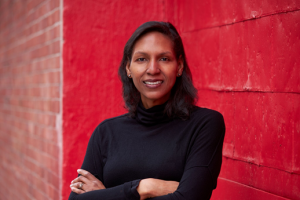
Courtney J. Martin, photo by Argenis Apolinario
As I have indicated, the field of British art–and of art history more generally—is developing and changing in such important ways, and I have no doubt that Courtney J. Martin, who just has begun her first term as the Center’s brilliant new director, will work with her YCBA colleagues not only to continue to introduce the work of new artists to the collection, but to encourage an ever-expanding community of visitors from the university, the city, the region, and the world through innovative displays, exhibitions, publications, and programs. She is a tremendous addition to the impressive complement of collection directors under the excellent leadership of Yale’s Vice Provost for Collections and Scholarly Communications, Susan Gibbons, and I expect that splendid developments are about to take place across all of the university’s museums and libraries with this gifted team in place.
JTP: What are you most proud of having accomplished at YBCA?
AM: My pride lies in what I was able to accomplish in concert with my superlative friends and colleagues: the staff of the YCBA and PMC, Yale students and faculty members, the 250 visiting scholars who have joined our community to pursue research in the YCBA’s collections, our advisory committees and consultants, the PMC’s Board of Governors, and supporters of both institutions. So much has been accomplished collectively that a full review would be impossible, but I will outline some of our most significant collaborative achievements.
Working with museums and cultural institutions across the UK, and in certain instances the United States, we developed a program of over fifty major loan exhibitions which explored a wide range of topics from the early modern period through the current day. These were underpinned by workshops involving students and scholars from around the world, and they were enhanced by an equivalent number of significant publications produced in association with Yale University Press London (YUPL). Approximately forty in-house exhibitions and displays, often developed with undergraduates and graduate students, enriched the exhibition program, examining the Center’s own holdings from important new vantage points.
One such exhibition, Unto This Last: Two Hundred Years of John Ruskin, curated by three of Tim Barringer’s graduate students—Tara Contractor, Victoria Hepburn, and Judith Stapleton—has been in the planning stages for some time as the Center’s central contribution to the bicentennial commemoration of Ruskin’s birth (both critical and celebratory), and it will open on the evening of September 17th of this year, accompanied by a leading-edge catalogue edited by Tim, to which the students, and others, have contributed. I have no doubt that for this cohort of students, the experience of working with Tim on an assessment of Ruskin’s significance as a thinker for the modern world will be as important as George Hersey’s Ruskin seminar was for me and my own group of peers over forty years ago.
During the last seventeen years, the research cultures of the YCBA and the PMC were augmented through the joint efforts of a new Research Division at the Yale Center and an amplified program at the London Centre, which also produced a superb run of publications with YUPL. Support of scholars across the field of British art was substantially increased through the PMC’s grant program and the YCBA’s visiting scholars program. The PMC and YCBA also collaborated to develop an innovative online journal, British Art Studies, which is fully accessible, free of charge, to the world.
The YCBA’s education program developed magnificently, as well. Our docents toured 92,929 school-age students through the galleries, and an average of 88 Yale classes utilized the collections each year, with nearly 14,000 Yale students visiting the Study Room either with a class or to use collections on their own. The Center hosted 903 undergraduate student interns and workers, 76 graduate student research assistants, and 20 postdoctoral research associates who received doctorates from other universities. Empirically based programs focused on close looking in the galleries, designed to increase both the sensitivity and diagnostic skills of medical and nursing students (the first such programs in the world), continued to develop for Yale graduate student in other fields.
Additionally, creative learning programs for teenage girls on the autism spectrum were put into place, and a teaching relationship with Chapel Haven, a home for adults with cognitive disabilities, flourished. The Center actively joined the university’s mentorship program to engage undergraduates who have attended New Haven public schools, or approved charter schools, and who have been awarded New Haven Promise scholarships, in professional experiences over the summer months. We benefitted from the fine work of those who were participants in the program, and we were able to add several extremely talented young people to our permanent staff from the program.
The collections also developed in exciting ways over the years, with curators adding to the historic corpus with important works from the Tudor period through the mid-twentieth century, and with modern and contemporary works expanding the Center’s holdings into our own time.
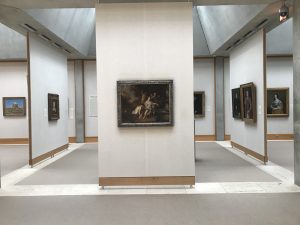
Fourth-floor gallery installation, including the new acquisition of Peter Lely’s Diana and her Nymphs at a Fountain (ca.1648), Yale Center for British Art, photo by Edward Town
Sculpture became a special focus of the acquisitions program, along with photography and modern and contemporary art. In all, almost 9,000 objects and collections across the curatorial departments amplified the Center’s holdings for teaching, research, and exhibition.
A program to make the Center’s entire collection accessible virtually, placed 90,000 records online, and 78,000 high-resolution digital images of works in the public domain freely available to the world for any use, in concert with Yale’s Open Access policy. The Center now seeks to connect these online collections with others across the university and the globe, through linked open data, allowing audiences worldwide to explore the rich global history of British art.
We also worked with collections across the university to develop a state-of-the-art conservation program on Yale’s West Campus, and to create the Institute for the Preservation of Cultural Heritage, with a major conservation science program intended not only for the technical assessment of our own collections, but also to address global conservation needs. Additionally, the Center published a model conservation plan for its landmark building designed by Louis I. Kahn, which has helped to steer the conservation of other modern buildings of cultural significance according to best practices. This plan allowed a three-phased conservation program to address the physical needs of the Kahn building, and following the conservation of the interior spaces and upgrading of the mechanical systems, a freshly conceived display of the art collections was installed, entitled “Britain in the World.”
JTP: What are you most excited about when you think of your next steps? Are there projects you are looking forward to?
AM: Returning to my own scholarship is a great joy, and I am beginning to work with Therese O’Malley to co-curate an exhibition examining the naturalists John and William Bartram and the early development of environmental thought in North America and the transatlantic world—a project that derives from the dissertations on which we worked together so many years ago, but that now is informed by the scholarship of those working on the culture of natural history in the Americas from new points of view.
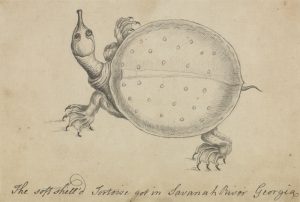
William Bartram, The Soft Shell’d Tortoise Got in Savanah River Georgia, ca. 1773, gray wash, pen and black ink, and graphite on paper, Yale Center for British Art, Gift of Charles Ryskamp
The Bartrams, who created one of the first scientific gardens in the British colonies, began to be mythologized in their own time, and have been the focus of academic study since the nineteenth century. However, their work is just beginning to be assessed in relation to the knowledge they gained not only from Native American peoples they encountered on their collecting expeditions, but from enslaved peoples of African descent in bondage to the Bartrams’ family members and friends throughout the southern colonies, as well as those William himself enslaved on a small, short-lived plantation that he attempted to establish in Florida. This project will serve as a case study examining the diverse systems of knowledge about nature that converged and collided in this period, resulting in new conceptions of a wholly interconnected cosmos, in a constant state of flux.
Amy Meyers BIOGRAPHY
Amy Meyers (Yale PhD, American Studies, 1985) retired from the directorship of the Yale Center for British Art on June 30th of this year. Prior to her appointment in July of 2002, she spent much of her career at research institutes, including Dumbarton Oaks; the Center for Advanced Study in Visual Arts at the National Gallery of Art, Washington, D.C; and The Huntington Library, Art Collections, and Botanical Gardens, where she served as Curator of American Art from 1988 through June of 2002. Meyers also has taught the history of art at the California Institute of Technology, the University of Michigan, Mount Vernon College, and Yale. As Director of the Center, Meyers sought to strengthen the institution’s educational and research initiatives. She endeavored to promote a rigorous academic publication program in association with Yale University Press and to develop an exhibition program of the highest scholarly standard in partnership with major museums across Europe and the United States. She expanded the Center’s fellowship program; amplified the teaching mission in concert with departments and programs across the university; and promoted the cataloguing of the collections on-line, with free and open access to all images in the public domain. Meyers supported the creation of a conservation plan for the institution’s landmark building, designed by Louis I. Kahn, and she oversaw the conservation of the building, as well as two full-scale reinstallations of the entire collection.
Meyers has written extensively on the visual and material culture of natural history in the transatlantic world, serving as editor of Knowing Nature: Art and Science in Philadelphia, 1740 to 1840, with the assistance of Lisa Ford (New Haven: Yale University Press, 2011); with Harold Cook and Pamela Smith, Ways of Making and Knowing: The Material Culture of Empirical Knowledge (Ann Arbor: The University of Michigan Press, 2011); with Therese O’Malley, The Art of Natural History: Illustrated Treatises and Botanical Paintings, 1400-1850 (Washington, D.C.: National Gallery of Art, Studies in The History of Art Series, 2008); Art and Science in America: Issues of Representation (San Marino: The Huntington, 1998); and, with Margaret Pritchard, Empire’s Nature: Mark Catesby’s New World Vision (Chapel Hill: University of North Carolina Press, 1998). She also has organized numerous international symposia in the field, including Curious Specimens: Enlightenment Objects, Collections, Narratives (with Luisa Calè, Michael Snodin, Margaret Powell, and Cynthia Roman; London, 2010), Ways of Making and Knowing: The Material Culture of Empirical Knowledge (with Hal Cook and Pamela Smith; London, 2005); and ‘Curious in Our Way’: The Culture of Nature in Philadelphia, 1740 to 1840 (Philadelphia, 2004). With Therese O’Malley, she currently is co-organizing an exhibition on John and William Bartram and the emergence of an environmental conception of the natural world in colonial and early republican America, to be mounted in 2024.
Celebrate Pride with CAA’s LGBTQ+ Article Collection
posted by CAA — June 13, 2019
Learn more about Art Journal and The Art Bulletin.
Explore SAH Archipedia, an Online Encyclopedia of American Architecture and Landscapes
posted by CAA — July 09, 2018
Hosted by CAA-affiliated society Society of Architectural Historians (SAH), SAH Archipedia is an online encyclopedia of US architecture and landscapes that contains peer-reviewed essays, photos, and maps. Since its launch in 2012, SAH Archipedia has grown in scope and the full version now contains nearly 20,000 building histories covering all 50 US states.
Currently, entries for over 3,700 structures are available to the public through the site’s open access counterpart, SAH Archipedia Classic Buildings.
SAH recently announced that SAH Archipedia will be made open access in 2019. Help SAH in this effort by donating before August 31 to secure their NEH matching grant.
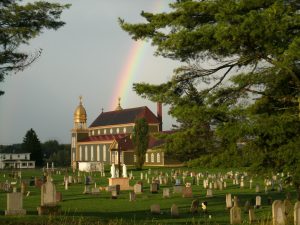
Musée Culturel du Mont-Carmel http://sah-archipedia.org/buildings/ME-01-003-0064 Photo Credit: Don Cyr
Call for CAA Member Feedback: Measuring College Learning in Art History
posted by CAA — February 16, 2018
In 2013 the Social Science Research Council (SSRC) launched the Measuring College Learning (MCL) project as a way to engage faculty in the effort to understand and improve student learning in their discipline through development of better tools for assessment in higher education. CAA recently partnered with the SSRC to create an MCL-Art History panel that would outline learning objectives for introductory art history courses, including identifying essential concepts and competencies that demonstrate foundational knowledge of the discipline. The MCL-AH panel convened in July and December 2017 to produce a draft document.
The MCL-Art History panel will host an open forum at the CAA Annual Conference from 2:00-3:30 PM on Friday, February 23rd in Room 511A of the Los Angeles Convention Center to collect CAA member feedback on its initial draft of core learning goals. The panel plans to share the draft document, solicit input and observations, and respond to questions from the community. CAA members are also invited to review the draft document and share observations before, during, and after the annual conference (until March 31, 2018).
Link to MCL-AH Document: http://highered.ssrc.org/wp-content/uploads/2018.02-MCL-in-Art-History-Report-for-CAA.pdf
CAA Member Feedback to: edick@ssrc.org
Background on the Measuring College Learning Project
In MCL projects faculty and other experts come together to consider what students should learn in their majors and how that learning should be measured. Panels of experts from six disciplines participated in the first iteration: biology, business, communication, economics, history, and sociology. Several national disciplinary associations—including the American History Association, the American Sociology Association, and the National Communication Association—were actively involved in this project. The culmination of this work was the publication of Improving Quality in American Higher Education: Learning Outcomes & Assessments for the 21st Century (Jossey Bass, 2016). More information and resources from this project are available on-line for free download at: http://highered.ssrc.org/projects/measuring-college-learning-project/.
MCL-Art History Panel Members:
Richard Arum, University of California-Irvine, SSRC Senior Academic Advisor
Cole Edick, SSRC Program Assistant
Christine Havice, Kent State University
Richard Lubben, Lane Community College, CAA Education Committee
Elisa Mandell, California State University Fullerton, CAA International Committee
Walter Meyer, Santa Monica College, CAA Professional Practices Committee
Chika Okeke-Agulu, Princeton University, CAA Board of Directors
Stephanie Smith, Youngstown State University
MCL-Art History Co-Chairs:
Virginia Spivey, Independent Scholar and Consultant, CAA Education Committee
Andy Schulz, Penn State University, CAA Board of Directors
Jim Hopfensperger, Western Michigan University, CAA Board of Directors
Refining Hiring Standards for Part-Time Faculty
posted by CAA — November 02, 2017
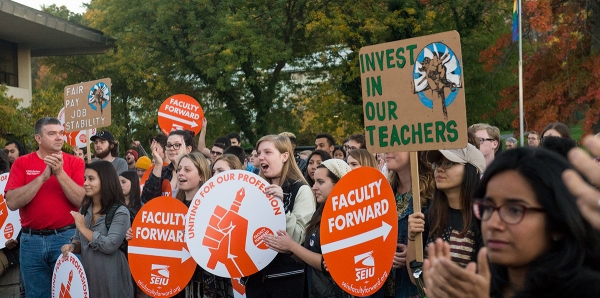
Students and faculty protest at Ithaca College, 2016. Image courtesy Tompkins County Workers’ Center.
CAA is committed to supporting all professionals in the field. This especially pertains to those who are applying for and working as part-time faculty members. For more than twenty years, CAA has been setting standards for hiring part-time faculty.
CAA’s current guidelines are published here and copied below. We want to hear from members about how these might be updated and strengthened.
Hunter O’Hanian
College Art Association
Executive Director and Chief Executive Officer
CAA Guidelines for Part-Time Professional Employment
Part-time employees play a critical role within the art world, specifically in academia, museums, galleries, and other arts institutions. They help meet curricular demands, offer expertise in specialized areas, and/or provide leadership in institutional programming.
Part-time faculty may be referred to with the following terms: adjunct, temporary, lecturer, graduate assistant, and teaching assistant. The terminology and its implications may vary from institution to institution, with the designation “part-time” or “temporary” serving as the most general and therefore consistent names. While this standard is primarily concerned with addressing the conditions of fully credentialed and professionalized part-time or short-term employees who are not simultaneously graduate students, this guideline may be relevant to those employed in conjunction with their graduate studies.
Part-time/temporary faculty and other part-time/temporary employees may be understood to be of several types: Part-time/temporary employees who would prefer full-time positions, part-time/temporary employees with no other employment, part-time employees who teach/work in addition to other full-time employment, and part-time/temporary employees who are retirees. Additionally, some institutions have paid, professional visitors that are not ongoing, full-time employees and also are not recurring, part-time employees. With this in mind, it is acknowledged that there is no singular reason one seeks part-time employment, and while each person may have individual reasons and needs, CAA encourages institutions to chart a path of continual improvements and aspire to provide the best possible working conditions for all part-time/temporary professionals, especially given the increasing reliance on such professionals.
Among key areas of concern are: equitable compensation; employment stability; access to employee benefits, including health care; access to professional development; and safe and adequate working conditions.
Within academia, these areas of concern may be assessed and addressed by comparing part-time faculty roles against full-time tenured/tenure-track faculty roles. Where similar work is performed and similar institutional expectations are held, equitable compensation and resources should exist. Where the treatment of employees in full- and part-time categories is dissimilar, the differences in expectations/compensation and the reasons for those differences should be articulated to both groups.
Institutions that regularly have visiting or guest faculty or curators should define how such roles are similar and different from other full-time and part-time employee roles. If the visiting appointment has responsibilities most similar to a comparable full-time position, the compensation should resemble such a full-time position.
Certain rights and responsibilities should be consistent regardless of one’s employment category. For example, academic freedom should provide the same protections for all. So too should workers’ compensation and other applicable laws that offer employee safeguards.
Working Conditions for Part-Time Employees
Given the great range of mission and expectations in institutions, it is essential that institutions define the roles of part-time employees and provide them with this information as well as information on their workplaces.
- The following written information should be provided by the institution at the time of employment.
- Institutions with a significant number of part-time employees may wish to create and use a part-time employee handbook.
- Statement on the institutional/departmental mission or philosophy
- A full description of the part-time position, including a definition of the role and duties (in the case of faculty, this would include class title, description, size, contact hours, advising responsibilities, and any other responsibilities)
- Description of teaching facilities, office facilities, and support services
- In the case of art and design faculty, description of and access to studio facilities or teaching and for personal, professional development
- Description of financial support and resources available for performing the work and for personal, professional development
- Information on evaluation and promotion procedures
- Information on employment security
- Information on institutional governance and opportunities to participate in it
- Information on any and all institutional expectations
- A written contract for part-time employment should explicitly state the following:
- Compensation including salary, benefits, and any other compensation
- Duties and responsibilities
- Duration of employment
- Process and timing of evaluation
- Availability and timing of contract renewal
- For part-time/temporary faculty:The standards of excellence defined by visual arts programs should be founded upon realistic criteria
- Generally, part-time/temporary faculty do not have research/creative activity duties; if such expectations exist they should be stated in the contract and the faculty member compensated for them
- Part-time/temporary faculty may or may not have service obligations; if service duties are assigned, the faculty member should be compensated for them
- Institutional expectations should take into consideration changes in academia, the commercial
marketplace, and the discipline in question - Whenever possible, faculty should be included in the design of the course taught
- If a course is to be canceled due to under-enrollment or another issue, the faculty member should be notified in a timely manner; if it is canceled at the last minute, the faculty member should be compensated, either in full or on a pro-rated basis for course preparation
- Part-time faculty should have access to private (or shared with the expectation
of privacy when needed) office space for student/teacher meetings - If a part-time faculty member’s institutional contribution is equivalent to that of a full-time faculty member, the part-time faculty member should be equitably compensated in comparison to such a full-time faculty member. If there is no expectation for research or service, differential compensation may be significant. This should be clearly stated in contractual materials.
- For all part-time employees:
- Personal and environmental safety should be a major concern with adequate protection provided by the employer
- OSHA, EPA, and other relevant standards should be followed
- Institutional practices for ensuring safety should be clearly communicated
- Opportunities for advancement in rank, salary, and responsibilities should be given to recurring, part-time employees.
- Adequate administrative support should be provided: mailbox; office space; telephone and computer access; clerical support; library facilities; and teaching/research support such as assistants and/or graders, when warranted
- When additional duties are offered or assigned, and such duties are ones often performed by full-time employees and go beyond the regular scope of part-time employment, the part-time employee should be offered additional and adequate compensation, such as a stipend
The 2013 ad-hoc committee for revision was co-chaired by Thomas Berding, Michigan State University and John Richardson, Wayne State University. The committee included Janet Casey, Skidmore College; Zoe Darling, Milwaukee Institute of Art and Design; Jim Hopfensperger, Western Michigan University; David LaPalombara, Ohio University; Dennis Nawrocki, Wayne State University; and Kate Wagle, University of Oregon.
New in caa.reviews
posted by CAA — September 23, 2016
Alison C. Fleming reads Federico Barocci and the Oratorians: Corporate Patronage and Style in the Counter-Reformation by Ian F. Verstegen. The book “efficiently tackles the subject” of “the interior decoration of the Chiesa Nuova in Rome,” with a focus on Federico Barocci “and how his style corresponded so well to the tenets of the Oratorians that they repeatedly sought his paintings.” Read the full review at caa.reviews.
Claudia Swan reviews Benjamin Schmidt’s Inventing Exoticism: Geography, Globalism, and Europe’s Early Modern World. Merging historical and art-historical elements, this “formidable study” examines artworks and luxury goods “produced in Dutch ateliers between 1670 and 1730 under the rubric of ‘exotic geography,’” which the author views as “a new rhetorical and artistic mode.” Read the full review at caa.reviews.
Carol Damian discusses two books centered on the questions of what is a Latino and what is Latino art: Thirteen Way of Looking at Latino Art, by Ilan Stavans and Jorge J. E. Gracia, and Our America: The Latino Presence in American Art, an exhibition catalogue from the Smithsonian American Art Museum. Both books evidence how “the entire Latino issue is a construct, complicated, and imperfect” and “make valuable contributions to this ongoing discussion.” Read the full review at caa.reviews.
Caa.reviews publishes over 150 reviews each year. Founded in 1998, the site publishes timely scholarly and critical reviews of studies and projects in all areas and periods of art history, visual studies, and the fine arts, providing peer review for the disciplines served by the College Art Association. Publications and projects reviewed include books, articles, exhibitions, conferences, digital scholarship, and other works as appropriate. Read more reviews at caa.reviews.



